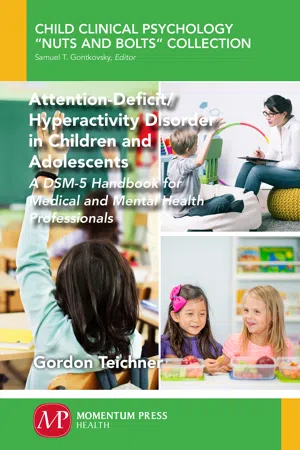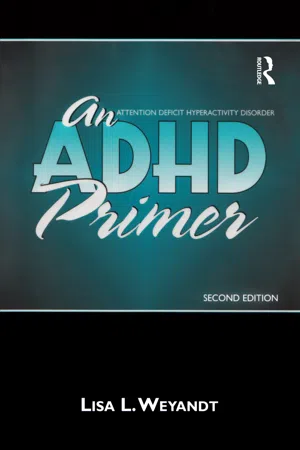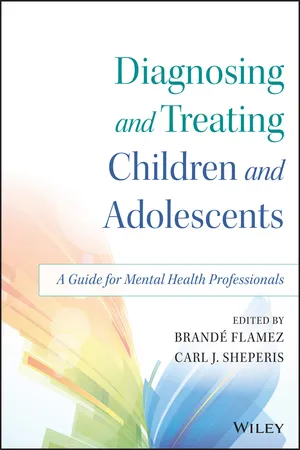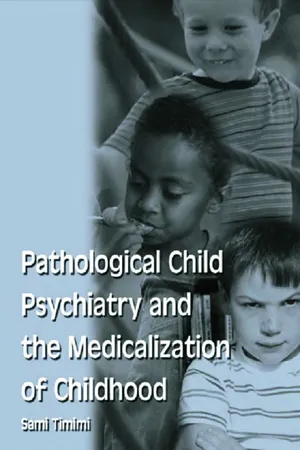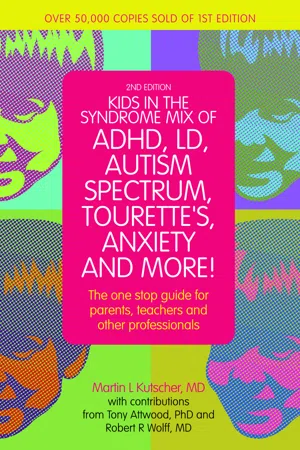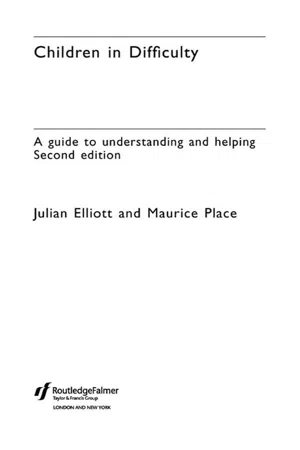Psychology
Attention Deficit Hyperactivity Disorder
Attention Deficit Hyperactivity Disorder (ADHD) is a neurodevelopmental disorder characterized by inattention, hyperactivity, and impulsivity. It often begins in childhood and can persist into adulthood. Symptoms can impact academic, occupational, and social functioning. Treatment typically involves a combination of medication, behavioral therapy, and support strategies tailored to the individual's needs.
Written by Perlego with AI-assistance
Related key terms
8 Key excerpts on "Attention Deficit Hyperactivity Disorder"
- Gordon Teichner(Author)
- 2017(Publication Date)
- Momentum Press(Publisher)
CHAPTER 1Description and Diagnosis of Attention-Deficit/Hyperactivity DisorderDSM-5 Diagnostic Criteria for Attention-Deficit/Hyperactivity DisorderAttention-Deficit/Hyperactivity Disorder (ADHD) is a neurodevelopmental disorder that is characterized by symptoms of inattention, impulsivity, and hyperactivity that are inconsistent with a child’s developmental level. Several symptoms must be displayed across two or more settings. Difficulties associated with ADHD must significantly interfere with, or reduce the quality of, the child’s functioning (e.g., at home, at school, in academic performance, in leisure activities, in relations with others, in managing daily responsibilities) in order to meet the criteria for this diagnosis.Symptom onset has been changed in DSM-5 (American Psychiatric Association, 2013) to prior to the age of 12 years; several symptoms of inattention, hyperactivity, and impulsivity must have been present prior to this age in order to meet the DSM-5 diagnostic criteria. DSM-IV (American Psychiatric Association, 1994) and DSM-IV-TR (American Psychiatric Association, 2000) definitions required a symptom onset prior to the age of seven years in order to meet diagnostic criteria for ADHD.ADHD is a neurodevelopmental condition that can result in a range of functional difficulties for the child. Males and females generally display equal levels of persistent academic, behavioral, and social problems (Hinshaw et al., 2012). Such difficulties may include academic underachievement, learning disorders, externalizing behavior problems, psychological difficulties, problems with peer relations, and substance usage. Such issues often precipitate a referral to evaluating and treating clinicians.DSM-5 indicates that the prevalence of ADHD in children is about 5 percent across cultures. ADHD is more frequently demonstrated by boys, with a ratio of approximately 2:1 in children. Girls are more likely to primarily demonstrate symptoms comprising the ADHD symptom cluster of Inattention.- eBook - ePub
- Lisa L. Weyandt(Author)
- 2017(Publication Date)
- Routledge(Publisher)
CHAPTER 1Attention-Deficit/Hyperactivity Disorder—What Is It?He never sits still; he is constantly in motion. She never pays attention, and she talks incessantly. He cannot hold down a job. She is not doing well in school. The teachers say she is lazy. He does not follow through on anything, and he loses everything. He is so disorganized! She has been this way as long as I can remember.Description
Although these statements can be true of most children, adolescents, and adults at some point in their lives, they are typical concerns expressed by parents, teachers, spouses, and siblings about individuals with attention-deficit/hyperac-tivity disorder (ADHD). ADHD, as it is currently defined by the American Psychiatric Association (2000), is characterized by persistent and developmentally inappropriate problems with attention, impulsivity, and hyperactivity that cause impairment in one’s life. The presence, absence, or combination of these three symptoms reflects the severity and subtype of ADHD. Research findings indicate that ADHD is a lifelong condition that impacts an individual’s educational, social, and occupational life.Does ADHD Exist?
In the year 2000, the National Institutes of Health (NIH) released a consensus statement concerning the diagnosis and treatment of ADHD (National Institutes of Health, 2000) and indicated that “despite the progress in assessment, diagnosis and treatment of children and adults with ADHD, the disorder has remained controversial.... The controversy raises questions concerning the literal existence of the disorder” (p. 182). This concern mirrors the views expressed by others such as Armstrong (1995), who has questioned the authenticity of ADHD, and Baughman (2004), a neurologist, who is the author of a video entitled “ADHD—Total 100% Fraud.” Although the concern may be well intended, research across behavioral, genetic, neuropsychological, and neuro-physiological disciplines supports the existence of ADHD; and a diagnosis of ADHD can be made reliably using various assessment methods discussed in later chapters. In fact, the NIH consensus statement after thorough review of the scientific evidence concludes that ADHD is a valid disorder and this perspective is endorsed by the American Academy of Pediatrics, the American Medical Association, the American Psychiatric Association, the American Psychological Association, the National Association of School Psychologists, the U.S. Surgeon General, and others. In 2002, a consortium of international scientists addressed the assertion that ADHD is a fraud by reviewing the scientific evidence to the contrary and issued the International Consensus Statement on ADHD (2002). - eBook - ePub
Diagnosing and Treating Children and Adolescents
A Guide for Mental Health Professionals
- Brandé Flamez, Carl J. Sheperis(Authors)
- 2015(Publication Date)
- Wiley(Publisher)
No one single assessment instrument or one single observation of a child or adolescent can provide the opportunity for the comprehensive set of information required to make an accurate diagnosis of ADHD. Because ADHD is a highly heritable disease, a family history with medical and psychological records is a vital component of any complete appraisal. Finally, review of the DSM-5 diagnostic criteria along with information from multiple sources provide the best opportunity for an accurate diagnosis that would lead to effective treatments, including psychotherapy, behavior modification, psychoeducation, and pharmacological intervention for ADHD. Summary ADHD is a neurodevelopmental disorder marked by inattention, hyperactivity, and impulsivity. Although the symptoms of ADHD can appear well into adulthood, the diagnostic criteria in the DSM-5 require that symptoms be present prior to the age of 12, and even though adults may have symptoms of ADHD, recollection of those past events is helpful to contribute to an accurate diagnosis. As in the DSM-IV-TR, the DSM-5 necessitates six symptoms in one or both of the two categories of inattention and hyperactivity-impulsivity. For older adolescents and adults (age 17 and older), at least five symptoms are required. Although there have been descriptions of people with the symptoms of ADHD for as long as narratives of human life have existed, ADHD in the clinical sense first appeared in the DSM-II in 1968, though it was then called hyperkinetic reaction of childhood. Since that time, volumes of research have been published about the etiology, symptoms, and treatment of this neurodevelopmental disorder. Today's formulation in the DSM-5 (2013) joins the inattention and hyperactivity areas needed to make a diagnosis - eBook - ePub
- Randall I. Atlas, Richard J. Morris, Thomas R. Kratochwill(Authors)
- 2007(Publication Date)
- Routledge(Publisher)
5
Attention Deficit Hyperactivity Disorder
George J. DuPaul and Russell A. BarkleySymptoms of Attention Deficit Hyperactivity Disorder (ADHD; American Psychiatric Association, 2000) are among the most frequent referral complaints to child mental health professionals in this country. Epidemiological studies indicate that this disorder occurs in 3 percent to 8 percent of the school-age population (Barkley, 2006). As a result, ADHD continues to be one of the most heavily studied psychological disorders of childhood. Given its relatively high prevalence rate, it behooves clinicians as well as students of clinical child psychology and related disciplines to be able to assess this disorder competently and to design interventions that will effectively ameliorate both the core disorder and its associated deficits. The purpose of this chapter is to briefly review several treatment interventions that have demonstrated efficacy in the therapeutic management of ADHD and to provide an update regarding research into the salient parameters and outcomes associated with these interventions.This chapter is not designed to be an exhaustive review of the literature on the treatment of children with ADHD, as this has already been accomplished (e.g., Barkley, 2006). Further, because there are many problems associated with ADHD, in addition to core deficits, it would be impossible to delineate all of the treatment interventions used with this population. The reader is directed to those chapters in this text that address these problems (aggressive behavior, academic problems, depression) in more detail. Alternatively, this chapter will focus on the core behavioral deficit felt to be central to ADHD; impaired delayed responding or impulsivity (Barkley, 2006). The emphasis previously given to problems with attention and/or excessive motor activity appears to be accounted for by a central impairment in delaying responding to the environment. This central deficit is associated with and possibly may give rise to equally salient problems with working memory, often mistaken for attention problems. Because both factors are essential to self-regulation, ADHD is therefore a disorder of self-regulation as well. This combination of deficits likely accounts for the myriad problems that lead children with ADHD into chronic conflict with their social environment, cause them to be referred for treatment, and underlie their poor long-term adjustment. - eBook - ePub
The Effective Teacher's Guide to Behavioural and Emotional Disorders
Disruptive Behaviour Disorders, Anxiety Disorders, Depressive Disorders, and Attention Deficit Hyperactivity Disorder
- Michael Farrell, Michael Farrell(Authors)
- 2010(Publication Date)
- Routledge(Publisher)
On the other hand, this does not imply that the current understanding of what is called ADHD; its definition, assessment and provision cannot be refined and improved. Furthermore, some of the points raised by critics of the ADHD label require careful consideration. One concern is that the label may lead to shifting of responsibility for parents and schools. Another is that cultural influences such as mass media, limited opportunities for active play, and higher expectations of younger children may be influential. They may be contributing to a general increase in behaviour that is less compatible with the usual requirements of education and an over-identification of apparent ADHD.ADHD may be over-diagnosed, suggesting more careful assessment and a greater awareness of contributory factors. Some children do seem to experience very severe difficulties that cannot be explained away sociologically or by postmodern discourses. These can be identified by the category of ADHD with potentially helpful implications for provision for the child. At the same time it is possible the supposed condition is over-diagnosed. The challenge is to refine and be more robust about identification after seriously considering alternative explanations and approaches for elements of the behaviour associated with ADHD.Definitions
Several disorders relate to difficulties concerning over-activity, impulsivity and problems sustaining attention. Among terms that have been used for these are:• attention deficit disorder • hyperkinetic disorder • minimal brain dysfunction • hyperkinesis • minimal brain damage • disorder of attention motor control and perception.Currently the most widely used term is ADHD. This term emerged from attempts to describe inattentive, overactive and impulsive behaviour. The DSM-IV-TR - Sami Timimi(Author)
- 2014(Publication Date)
- Routledge(Publisher)
In the UK child psychiatrists have, in the past, generally followed the diagnostic guidelines of the International Classification of Diseases (ICD) in preference to DSM. The latest edition of ICD (ICD-10, World Health Organization, 1990) has a more explicit definition of hyperkinetic disorder than its predecessor, ICD-9. In common with the trend in DSM revisions, centres that have changed from using ICD-9 to ICD-10 criteria, have also noticed that the diagnosis is being made more frequently (Steinhausen and Erdin, 1991). However, practice in the UK is now moving towards using ADHD as the diagnosis in preference to hyperkinetic syndrome thereby following the terminology used in American practice. Along with Coca-Cola, McDonalds and Hollywood, domination of the world’s markets allows American culture to be successfully exported. An enthusiastic drug industry and drug-industry-funded pro-Ritalin® parent groups, helped establish ADHD as the main diagnostic label to use. This is evident from the fact that clinics being set up in this country, both private and National Health Service clinics, call themselves ADHD clinics as opposed to hyperkinetic disorder clinics. Titles used in publications, media reports and academic conferences commonly refer to ADHD. Attention deficity hyperactivity disorder has taken over as the main term being used.A leap of faith
So what is the evidence for the existence of this disorder? Is there a medical test that will diagnose it? No. Are there any specific cognitive, metabolic or neurological markers for ADHD? No. Attention deficity hyperactivity disorder is a cultural construct diagnosed on the basis of clinical opinion and faithful belief of the practitioner and is often presented as if it were a biological fact. Those who have argued that ADHD does not exist as a real disorder start by pointing to the obvious uncertainty about its definition (McGuinness, 1989). Indeed, despite years of work and billions of dollars spent on research, the validity of ADHD or hyperkinetic disorder as a disorder distinct from other types of behavioural disturbances in childhood, particularly those involving aggressive and defiant behaviours, has not been established (Prior and Sanson, 1986; Werry et al ., 1987a, 1987b). Thus, because of the uncertainty about definition it is hardly surprising that epidemiological studies have produced very different prevalence rates for ADHD or hyperkinetic disorders, ranging from about 0.5 per cent to about 17 per cent of school-age children (Taylor and Hemsley, 1995; Szatmari et al ., 1989a).Epidemiological studies have found a preponderance of boys over girls in ADHD symptomatology, in the region of four (or more) boys to one girl (McGee et al ., 1992). This is very similar to the gender distribution found in conduct disorder and other so called externalizing behavioural disorders in children. The meaning of this gender distribution never seems to be questioned. What sort of biological variable are we attempting to categorize here if this is a biological abnormality? Is it that boys generally have bad genes compared to girls? Is it something to do with the normal biological differences between male and female genes? Is there an interaction between boys’ behaviour and changes in social expectations regarding children’s behaviour generally? Do social changes in family structure, lifestyles, teaching methods, classroom sizes, rates of violence, rates of substance misuse and so on have an effect on perceptions and beliefs about boys’ and girls’ behaviour, or even on their behaviour directly? Has life got harder for boys in some way? Has life got harder for parents trying to control normal boy behaviour? Are we still compelled to pay more attention to the externalized behaviour of boys than to the internalized behaviour of girls, only now we medicalize this (after all adults in western societies are usually more tolerant of hyperactivity in girls than in boys (Battle and Lacey, 1972))? Do changes in teaching methods and a predominance of female teachers have an effect on how we understand and deal with boys’ behaviour? These and other social and cultural questions are never discussed in the medical literature. The gender distribution problem has led some researchers to try and bypass this clear, cultural, construct problem by rather creatively suggesting that biologically the same disorder may present as attention deficit without hyperactivity in girls, thereby evening out the gender ratio (Lahey et al- eBook - ePub
Kids in the Syndrome Mix of ADHD, LD, Autism Spectrum, Tourette's, Anxiety, and More!
The one-stop guide for parents, teachers, and other professionals
- Martin L. Kutscher(Author)
- 2014(Publication Date)
- Jessica Kingsley Publishers(Publisher)
CHAPTER 3 Attention Deficit Hyperactivity DisorderBobby’s mom has ADHD, also. Once, while joking about her chaotic life, she said, “I aspire to have obsessive compulsive disorder—so that I might be more organized.” She was serious. Defining ADHD “Official” (and woefully incomplete) definition of ADHD“Okay, Bobby has ADHD (Attention Deficit Hyperactivity Disorder). That explains why he doesn’t seem to pay attention and is so fidgety. But I still don’t understand so many things about him. Why is he so disorganized? Why won’t he write down his homework assignments? Why doesn’t punishing him seem to have any effect? Why doesn’t he see the consequence of his actions? Why does his mother say that homework is such a fight? Is it true that he blows up so easily at home?”The American Psychiatric Association gives “official” criteria for many syndromes in the Diagnostic and Statistical Manual of Mental Disorders-5 (APA 2013), commonly referred to as DSM-5. As typically defined by DSM-5, ADHD consists of a triad of inattention and/or hyperactivity-impulsivity.Symptoms of the “inattentive” type• Attention and distractibility problems are a core symptom of ADHD. There is an inability to inhibit distractions in order to stay focused on the task at hand. The person does not seem to listen or pay close attention. There may be frequent careless mistakes.• Organizational difficulties are an equal part of the problem. This includes difficulty organizing, sustaining, or completing tasks. The person may be forgetful, “absentminded,” or easily lose things.Symptoms of the hyperactive-impulsive type• Hyperactivity difficulties - eBook - ePub
Children in Difficulty
A guide to understanding and helping
- Julian Elliott, Maurice Place(Authors)
- 2004(Publication Date)
- Routledge(Publisher)
et al. 1983).- Impulsiveness is where a child will act upon a wish or desire without thought to its consequence. In some situations this can take the form ofquite dangerous behaviour (such as running into roads), but most often it is a pattern of breaking rules without thought as to what might happen as a result.
Diagnostic considerations
The confusion over labelling has recently become clearer. The Government guidance on the appropriateness of the diagnosis of Attention Deficit Hyperactivity Disorder (ADHD) (National Institute for Clinical Excellence 2000), and the wealth of research looking at the origins of such symptoms, has allowed the diagnosis of ADHD to become established, and the details of the diagnostic criteria for this condition are set out in figure 4.1.The proposal that problems with maintaining attention are at the heart of the difficulties is an attractive one, and much research effort has been concentrated on trying to delineate the mechanism. The attraction comes in the way that the observed symptoms would be logically explained by a difficulty in regulating the wealth of sights, sounds and information which press in upon all of us. If our filtering mechanisms should falter it must have a profound effect upon our functioning.
Learn about this page
Index pages curate the most relevant extracts from our library of academic textbooks. They’ve been created using an in-house natural language model (NLM), each adding context and meaning to key research topics.
